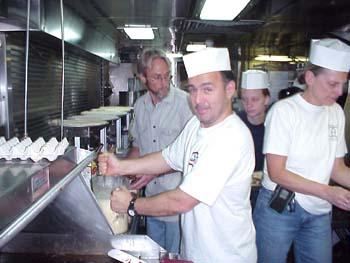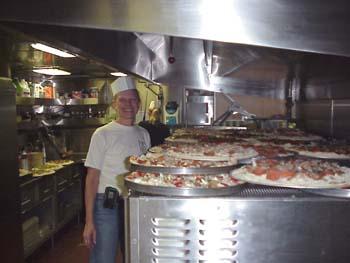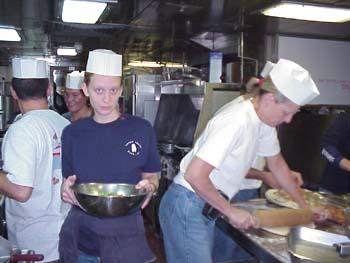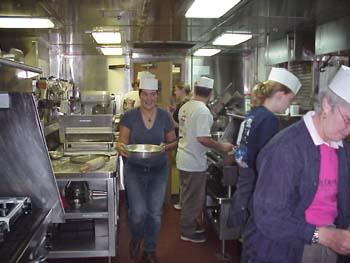
|
|
10 August, 2002
Saturday is morale day for the crew, and one thing that happens on morale
day is that a group other than the cooks prepares the evening meal, serves
it, and cleans up afterward. You might remember that we had a barbeque on
the helicopter deck for the first Saturday we were on board. Tonight it was
our (the science team) turn to cook. Throughout the week we discussed the
menu and planned shifts for cooking and cleaning up. We needed alternates
for all the activities since you can never plan ahead as to when your turn
for sampling might come up. By the time we were done, most every member of
the science team parcticipated in one way or another.
First let me say that I have so much respect for the cooks after today's
experience! Even planning the menu was tricky. Although the cooks and many
of the crew and science team were anxious to have pizza, some people wanted
to try their own recipes. Since Christine Pequignet is from France, she
wanted very much to have quiche and two special French desserts. Others
opted for jalapeno poppers (deep-fried, stuffed jalapeno peppers.) Still
others wanted ice cream and brownies for dessert and deviled eggs for an
appetizer. What did we decide? We made it all! It took several of us
nearly four hours to prepare 27 large pizzas, two huge trays of deviled
eggs, six very large quiches, a big batch of brownies, and two exotic French
desserts. We barely finished in time to serve the nearly 125 people on
board. After serving, it took a cleaning crew of several people almost an
hour to clean the pots and pans and the mess hall. Not only do the cooks do
this three times a day (plus mid rats), but they use real silverware, trays,
and dishes. We were lucky to use paper and plastic. By the time we were
done, everyone was exhausted.
Science wise, we are now at the 2000 meter East Hanna Shoal station. That
means that each procedure involving sampling water from varying depths or
sampling the bottom takes considerably more time than at shallower stations.
One of the things that we notice when we sample the sediments is that there
are very few organisms at that depth. That's because there is less organic
carbon being produced (there are less phytoplankton in the water) and
ultimately reaching the underlying sediments (the little that is there is
eaten by zooplankton and bacteria long before it reaches the bottom) than in
the shallower stations. We usually find even fewer organisms at the 3000
meter station. Jackie's data, combined with all that from the other science
teams will help to piece together a much better picture of what is happening
between the shelf and the basin in each of the areas we sample. I have
mentioned it before, but it bears repeating. Very little is known,
scientifically, about the Arctic Ocean! This is the area of the world where
global climate change may be most noticeable, and we have little data to
know what is going on now, never mind what might happen as a result of
global climate change in the future.
Someone reported a news item from a couple of days ago that said this is the
warmest summer in the history of the northern hemisphere. Certainly those
on board who have been doing research here for a number of years are finding
this to be a most unusual trip in terms of weather and ice. When Jackie was
sampling here in 1993, the area we are currently in was covered with a thick
ice pack. Today as I look out my porthole, I see only a few small ice floes
in the mostly open ocean. Certainly this could be just a warm summer for
the area. It could also be a part of a cycle of alternating warm and cold
periods. Or it could be a sign of a global warming pattern. You might
remember that a team of CBS newsmen was on board with us for four days.
They are hoping to do a one hour special as soon as possible, not only about
the research going on but about the issue of global climate change as well.
There are no easy answers, and it is only through scientific research that
we can gather enough information to start to understand the chemical,
biological, physical and geological factors that are at work in the Arctic
Ocean.
On additional note: Steve Roberts took all the cooking photos.

Sandor Mulsow did a great job with the grill and the quiches! <>

We had pizzas lined up everywhere waiting to go in or just coming out of the ovens. T <> hat's me standing next to them.

We finally got to serve! <>

Laura Belicka manages to find a path between all of us working closely in the kitchen.

Christine Pequignet helped to prepare three French specialties, two wonderful desserts and quiche.
Contact the TEA in the field at
.
If you cannot connect through your browser, copy the
TEA's e-mail address in the "To:" line of
your favorite e-mail package.
|
